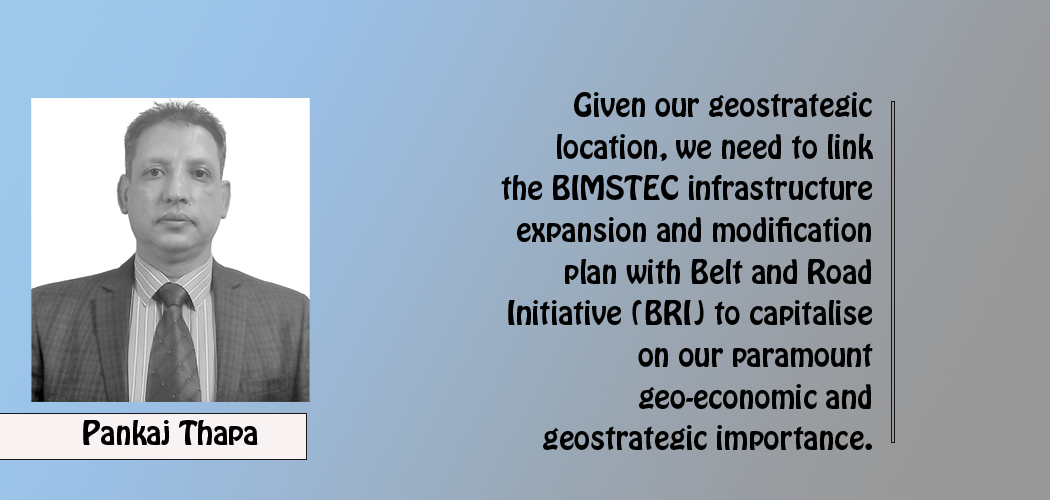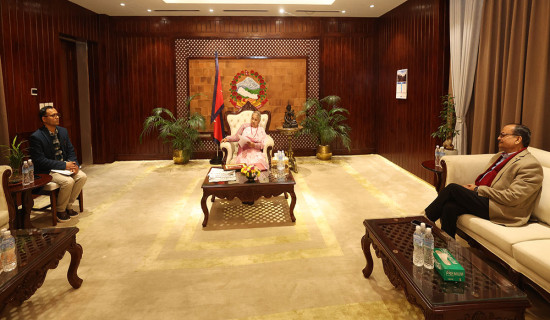- Wednesday, 7 January 2026
Materialising BIMSTEC Master Plan
Pankaj Thapa
Roads, rails, airways and inland water transports are some crucial connectivity tools for Nepal’s internal and cross-border trade improvement. Such connectivity creates linkage and jobs. It also helps in strengthening the capacity for strategic transportation networks. Timely implementation of the Bay of Bengal Initiative for Multi-Sectoral Technical and Economic Cooperation (BIMSTEC) Master Plan can play flagship role in our economic development and prosperity along with our other endeavors.
It is said that a river unites us but a dam divides us. This narrative has been developed over a period with all the dams that triggered conflict and differences all across the world. Nepal happens to be on the southern slope of the Himalayas. Our rivers mean the ones originating in our own territories or flowing from the Tibetan plateau and making the Bay of Bengal as their final destination meandering through Indian plains. The width of our southern plain and the size, and areas of arable land inversely proportionate to the availability of huge quantity of water discharge from glacier-fed rivers. So the dam constructions in a bigger size couldn’t serve our sole interest given the size of the capital investment and its return. Such infrastructure investment requires long term patient capital.
Mutual cooperation
It preferably requires Indo-Nepal's mutual trust and cooperation to optimise such a huge investment along with other international funding agencies. Here, we should rationalise that dams are not going to divide us; they indeed harmonise our relationship if we look at them with hope and opportunity. Besides irrigation, hydropower and drinking water, construction of sizable dams and other appropriate hydraulic structures across our mega rivers help to develop navigable rivers and channels downstream, which ultimately helps ease river-sea vessels and not merely river vessels to float. BIMSTEC Master Plan for Transport Connectivity envisioned the future benefits in developing sustainable and economically viable inland water transport especially multimodal and intermodal connectivity for member states that could impart more economic benefits to the landlocked member states like Nepal and Bhutan.
India, Bangladesh, Sri Lanka, Myanmar, Thailand, Nepal and Bhutan are the member states of BIMSTEC. In our case, it could provide access to the sea from Kolkata, Visakhapatnam, Chittagong and Mongla Ports. The Master Plan sets out 14 priority areas, out of which road transport is given more importance. In Nepali context, besides roads and road transport, railways and rail transport, inland water transport, civil aviation and airport, multimodal and intermodal transport, trade facilitation and human resource development hold huge potentiality. As part of signature projects, capacity enhancement of Tribhuvan International Airport (TIA), development of second international airport in the greenfield site at Nijgadh (though the Supreme Court has recently ordered to stop its construction), development of Inland Clearance Container Depots and development of Integrated Check Posts in different locations are also enlisted.
The 72.5-km Kathmandu-Terai Fast Track road, also considered as "Transformational Intervention", upgrading of 18-km Nijgadh-Pathalaiya road into four lanes, improving 146-km Narayanghat-Mungling-Kathmandu road (Narayanghat- Mungling section completed in 2018), upgrading of 1028-km East-West Highway, widening of Birgunj bypass to four lanes and construction of Mechi and Mahakali Bridges (Mechi Bridge completed) are some major roads and road transport projects which are incorporated in the BIMSTEC Master Plan as 'flagship’ projects.
Nepal needs to promote the development through closer linkage and it could be done applying two approaches. First is the Advanced Infrastructure Development (the hard approach) the second is the placement and enforcement of Agreement and Reforms (the soft approach). But on our part, we need to make our house in the orderly form to meet our obligation. Any delay in project construction leads to cost overrun and invitation of other drawbacks. To move on par with other member states' pace of developmental effort, we should resolve some chronic issues that hamper the timely completion of the major projects.
Linkage with BRI
Given our geostrategic location, we need to link the BIMSTEC infrastructure expansion and modification plan with Belt and Road Initiative (BRI) to capitalise on our paramount geo-economic and geostrategic importance. From China, Nepal is expecting a direct rail route connecting Kathmandu with Kerung as a cross-border railway project to have multiple links for trade and transit. As Nepal rests vertically above and on top of the Eurasian plate, because of fault effects of the deep and active factures, Kathmandu's section lies in the “collision and slicing zone”.
Around 95 per cent of railway infrastructure could either be tunnel or bridges as the high seismic activities like debris and water erosion, high ground temperature and constant destabilisation of slope always pose threat to such costly infrastructure. Despite all these challenges, we call for this engineering marvel to get materialised in order to transform Nepal as a land bridge between the BIMSTEC member states and the People’s Republic of China via our enchanting Himalayan corridor.
Smooth connectivity could be considered as an engineering marvel which calls for extensive testing; retesting, trials and modification, and that ultimately open up and explore new ideas and opportunities. But it is also not a foolproof solution to our economic leisureliness unless we make our service and production more competitive in the world market, taking the full benefit of such costly and advanced connectivity projects. So, along with BIMSTEC Master Plan and its implementation, we need to delve into more.
(Thapa is a former senior engineer of Nepali Army. pthapa.ktm@gmail.com)













-original-thumb.jpg)



